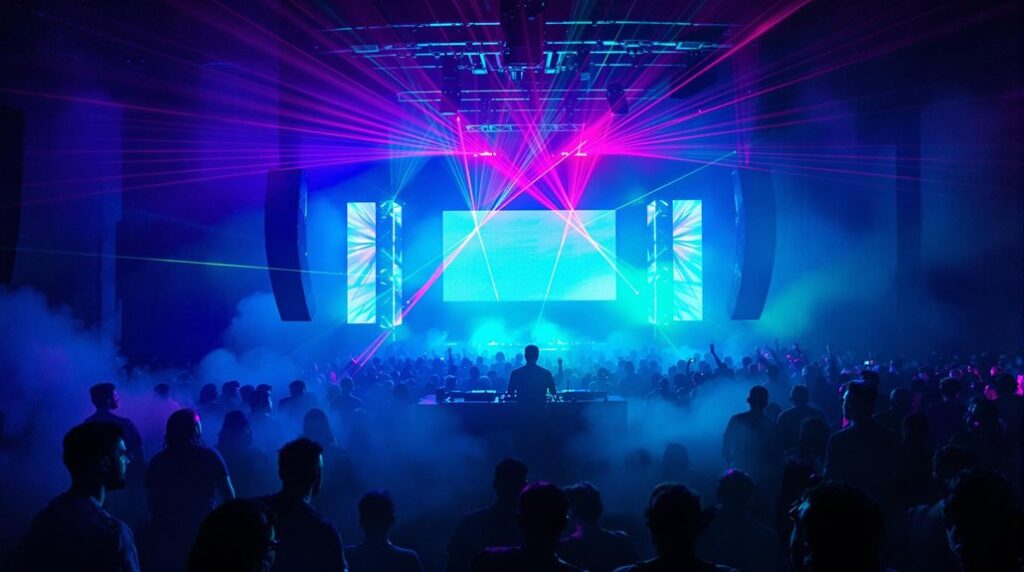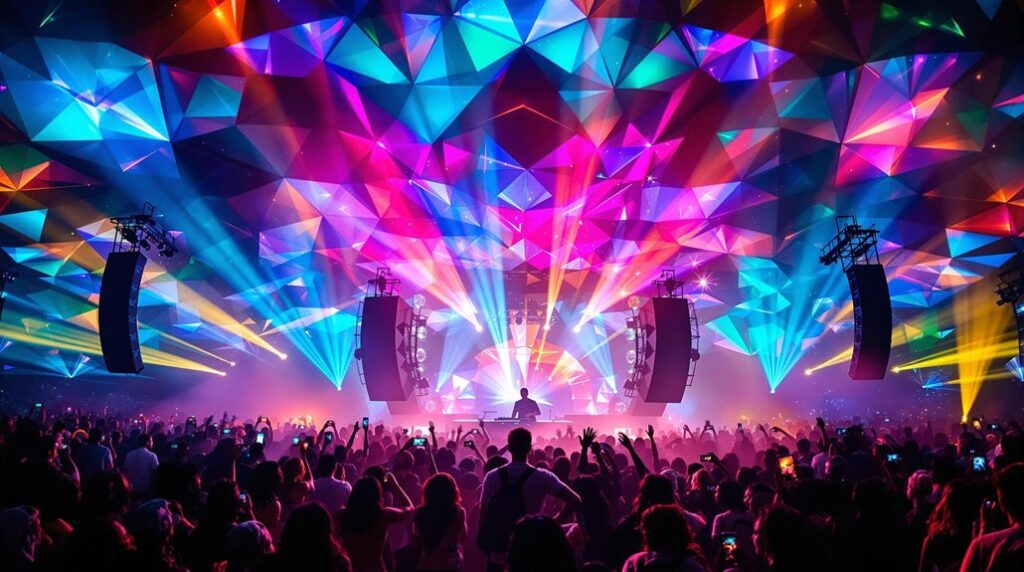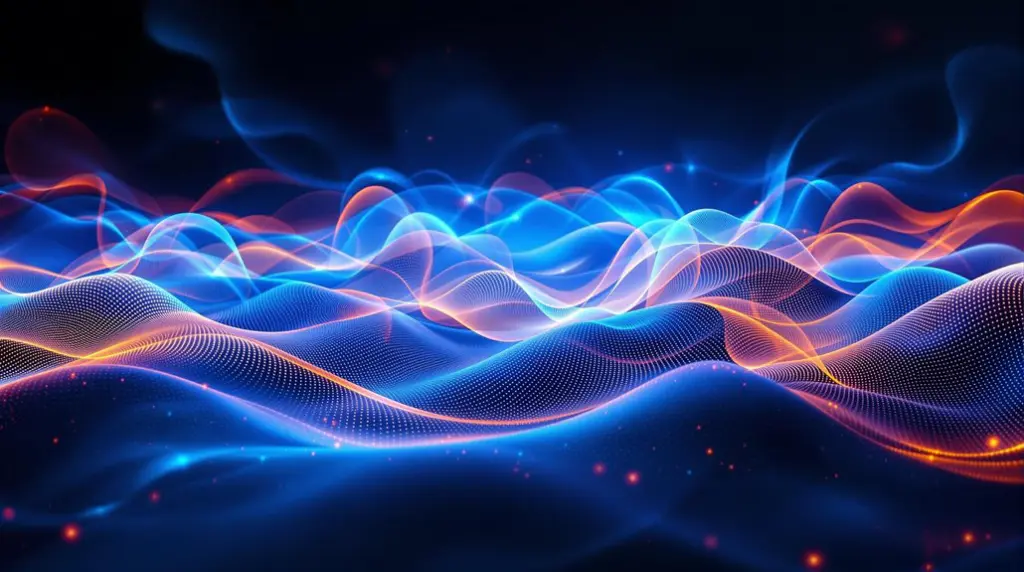Electronic music isn’t just transforming what you listen to; it’s revolutionizing the visuals that accompany it. Synesthetic experiences merge sounds with vivid, dynamic visuals, making each digital artwork a multisensory journey. Tools like Resolume Arena and TouchDesigner allow artists to synchronize and manipulate sound and visuals in real-time, intensifying your sensory engagement. Interactive installations respond directly to music, creating immersive environments that envelop you. Additionally, this fusion prompts a cultural shift, redefining how you perceive and interact with art. As the boundaries between audio and visual blur, you’ll discover new dimensions of artistic expression waiting just around the corner.
Key Takeaways
- Electronic music’s dynamic range inspires digital artists to create visually immersive experiences that reflect the music’s intensity.
- Real-time software tools like Resolume Arena enable artists to synchronize visuals with beats, enhancing live performance impact.
- Audio-reactive visuals in digital art transform electronic music into multidimensional sensory experiences, deepening audience engagement.
- Interactive installations with responsive visuals and lighting adapt to music changes, creating a cohesive and immersive environment.
- The fusion of electronic music and digital art is driving a cultural shift, redefining traditional boundaries and perceptions of art forms.
Synesthetic Experiences Unleashed
In the domain of digital art, electronic music‘s special capacity to fuse different sensory experiences opens up new creative possibilities, turning sounds into mesmerizing visual landscapes. This phenomenon, known as synesthetic experiences, allows you to perceive a blending where electronic beats and rhythms evoke vivid visual sensations. Imagine listening to a pulsating bass and simultaneously seeing vibrant, swirling colors that dance in rhythm to the sound. This sensory fusion isn’t just fascinating; it’s transformative in the world of art.
As you explore further, you’ll find that digital artists harness electronic music’s dynamic range and textures as a rich canvas for their creative interpretations. They employ color, shape, and movement to capture the essence and mood of the music, crafting artworks that resonate visually and aurally with their audience. This approach doesn’t just replicate the sound in visual form but rather, reimagines it, creating a multisensory experience that engages and captivates.
The synergy of sound and sight in these artworks not only enhances the emotional impact but also deepens the immersive nature of the experience. You’re not just observing; you’re feeling, hearing, and seeing the art in a profoundly integrated way.
Tech-Driven Artistic Collaboration
Tech-driven artistic collaborations frequently enhance how audiences experience electronic music and digital art, merging them through sophisticated software and interactive platforms. Artists aren’t just playing music or displaying visuals; they’re creating an ecosystem where each beat and pixel interacts dynamically. This synergy not only enriches your engagement as a viewer but also uplifts the entire aesthetic of the performance.
Using tools like Resolume Arena and TouchDesigner, artists achieve a seamless integration of sound and visuals, allowing them to synchronize every element of their performance. Imagine being at a live show where the pulsating rhythms of electronic music directly influence the swirling patterns on the screen. This isn’t just a concert; it’s an immersive experience that envelops you, making you a part of the creative process.
Moreover, these tech-driven collaborations open up avenues for creative experimentation that were previously unthinkable. Artists can now manipulate music and visual elements in real time, responding to the vibe of the audience or even the environment. Each performance becomes unique, a fleeting moment of artistic convergence that’s as transient as it’s mesmerizing. This is the frontier of digital art and music, constantly evolving and inviting you to not just observe but experience.
Visualizing Beats and Rhythms
Visual artists transform electronic beats and rhythms into dynamic visual displays using motion graphics and generative art, enhancing your sensory experience. This union of sound and sight isn’t just about adding visuals to music; it’s a form of creative expression that deepens your engagement with the art. By using tools like audio-reactive visuals and real-time animation software, artists synchronize every pulse and beat with visual elements that move and evolve in real-time.
Imagine colors, shapes, and textures that change with every thump and whisper of the music. This isn’t random; artists meticulously craft these elements to mirror and amplify the music’s emotional and rhythmic landscapes. The result? A sensory immersion that pulls you deeper into the music, letting you not just hear, but visually experience the rhythm.
Such visualizations are more than just an accompaniment; they’re an integral part of the performance, enhancing both the music and your experience of it. Each visual element is tuned to the music’s tempo, making the audio-visual performance a cohesive, immersive spectacle that represents a multidimensional expression of music, catapulting your sensory and emotional engagement to new heights.
Interactive Installations Impact
Interactive installations at electronic music events immerse you deeply, transforming your experience by making every beat and tone visually palpable. As the music pulses, the corresponding visuals on LED screens and projections adapt in real-time, enhancing the immersive environments created by artists. This synergy not only heightens your sensory experience but also intensifies audience engagement, making you feel like part of the artwork itself.
These installations do more than just accompany the music; they transform the space into a dynamic canvas where auditory and visual elements interplay uniquely. You’re not just at a concert; you’re inside a living, breathing art piece that responds to and evolves with the beats. This blend of technology and creativity pushes the boundaries of how electronic music is experienced.
Here’s a quick look at how interactive installations impact your experience at electronic music events:
| Feature | Impact on Experience |
|---|---|
| LED Screens | Enhances visual immersion |
| Projections | Expands the visual landscape |
| Interactive Lighting | Creates a responsive environment |
| Music Responsiveness | Synchronizes visuals with beats |
| Atmosphere Enhancement | Enhances mood and engagement |
Each component plays an important role in crafting a memorable experience that goes beyond listening to music, immersing you in a world where sound and sight are inseparably linked.
Cultural Shifts in Art Forms
As electronic music continues to evolve, it increasingly influences digital art, reshaping cultural landscapes and inspiring new forms of creative expression. You’re witnessing a fascinating era where the fusion of sound and visual aesthetics isn’t just happening; it’s revolutionizing how you perceive art. This cross-disciplinary exploration isn’t merely artists exploring new media—it’s a profound shift in the cultural fabric of art itself.
The synergy between electronic music and digital art exemplifies how technology and innovation aren’t just tools but catalysts for creative experimentation. You see, as electronic musicians manipulate beats and soundscapes, digital artists are taking cues to push the boundaries of visual expression. They’re not just adding visuals to music; they’re creating an immersive, sensory-rich experience that challenges how you engage with art.
This collaborative spirit is carving out new spaces where audiences don’t just observe but experience art. The result? Art forms that aren’t confined by traditional boundaries but are fluid, dynamic, and incredibly engaging. As you explore further into this evolving scene, you’re not just following a trend. You’re part of a cultural revolution, where each beat and pixel tells a story of innovation and unbridled experimentation.
Frequently Asked Questions
What Did Electronic Music Influence?
Electronic music influenced visual aesthetics and performance innovation in digital art. It spurred minimalistic, futuristic styles and interactive installations, enhancing the way you experience and interact with art in immersive, innovative environments.
What Best Explains Electronic Music?
Electronic music is defined by its use of synthesizer evolution and genre fusion. You’ll find it emphasizes rhythmic textures and digital innovation, reshaping how contemporary music integrates synthesized sounds and beats.
What Is the Important Role of Electronic Music in Today’s Genre?
You’re witnessing electronic music greatly shape today’s genres through cultural shifts and performance innovation, enhancing how audiences experience and interact with music on a deeply immersive and technologically advanced level.
How Does Music Relate to Technology?
Music’s intertwined with technology, especially in sound synthesis and technological evolution. You’ve seen how digital tools revolutionize creation, making electronic beats more intricate and immersive. It’s reshaping how you experience and create music.
Conclusion
You’ve seen how electronic music isn’t just about sound—it’s a spark for digital artistry. From igniting synesthetic experiences to forging tech-driven collaborations, artists are visualizing beats in immersive ways.
Interactive installations aren’t just exhibits; they’re reshaping how you interact with art, signaling a profound cultural shift. As you witness these transformations, remember: the fusion of digital art and electronic music isn’t just a trend, it’s the frontier of artistic innovation.
Embrace this evolving landscape.




